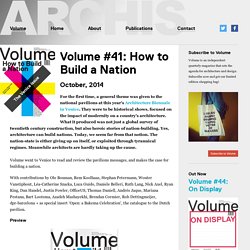

Volume #41: How to Build a Nation — Archis. October, 2014 For the first time, a general theme was given to the national pavilions at this year’s Architecture Biennale in Venice.

They were to be historical shows, focused on the impact of modernity on a country’s architecture. What it produced was not just a global survey of twentieth century construction, but also heroic stories of nation-building. Yes, architecture can build nations. Today, we seem far from that notion. With contributions by Ole Bouman, Rem Koolhaas, Stephan Petermann, Wouter Vanstiphout, Léa-Catherine Szacka, Luca Guido, Daniele Belleri, Ruth Lang, Nick Axel, Ryan King, Dan Handel, Justin Fowler, OfficeUS, Thomas Daniell, Andrés Jaque, Mariana Pestana, Bart Lootsma, Azadeh Mashayekhi, Brendan Cormier, Rob Dettingmeijer, dpr-barcelona + as special insert ‘Open: a Bakema Celebration’, the catalogue to the Dutch pavilion.
Preview Information Volume #41: How to Build a Nation — The Venice issue 144 p, ill. color and b/w 20×27 cm, pb, English ISBN: 9789077966426. About. Spatial Agency is a project that presents a new way of looking at how buildings and space can be produced.

Moving away from architecture's traditional focus on the look and making of buildings, Spatial Agency proposes a much more expansive field of opportunities in which architects and non-architects can operate. It suggests other ways of doing architecture. In the spirit of Cedric Price the project started with the belief that a building is not necessarily the best solution to a spatial problem. The project attempts to uncover a second history of architecture, one that moves sharply away from the figure of the architect as individual hero, and replaces it with a much more collaborative approach in which agents act with, and on behalf of, others. Although Spatial Agency started out as a critique of the conservative tendencies of mainstream practice, it ended up as a celebration of the bravery, canniness and optimism of an inspiring group of historical and contemporary figures.
Capitalism 2.0. Games for planning. Posted: December 5th, 2013 | Added by: Johan Tré | Filed under: Core Games, Games for decision-making, Games for planning, Games for vision and strategy meetings | Tags: benefit, cost, visual collab | No comments » This game is most probably the most simple collaborative cost benefit analysis ever.

It is applicable onto subjects where a group has expert knowledge about costs and/or benefits. A group of developers is such an example. Especially a customer or customer proxy will have interest when it comes to prioritizing work items. Generation ideas If the list of work items is not existent you can start this exercise by a silent post-up. Clustering Ask the team to group items together by subject in silence. In short: * does everybody know the scope of the clusters? Priories on cost Sorting Next, ask the team to sort them top to bottom on cost. (5 minutes of work) Park the items under discussion aside after all the others are done.
Write down on the board some marks of the scale. Conclusion.
Transition town. A transition town is a grassroot community project that seeks to build resilience in response to peak oil,[1] climate destruction, and economic instability.

Local projects are usually based on the model's initial '12 ingredients' and later 'revised ingredients'.[2][3] The first initiative to use the name was Transition Town Totnes, founded in 2006. The socioeconomic movement is an example of fiscal localism.[4][5] History[edit] Etymology[edit] The term, "transition town", was coined by Louise Rooney[6] and Catherine Dunne. The transition model can be applied to different types of place where people live, such as villages, regions, islands and towns. Influences[edit] Totnes, England[edit] In 2004, permaculture designer Rob Hopkins set his students at Kinsale Further Education College the task of applying permaculture principles to the concept of peak oil.
Hopkins moved to his hometown of Totnes, England, where he and Naresh Giangrande developed these concepts into the transition model. Storytelling.